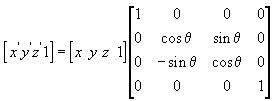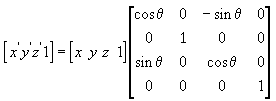|
|
|
|
Rotation |
The transformations described here are for left-handed coordinate systems, and so might be different from transformation matrices that you have seen elsewhere. For more information, see 3-D Coordinate Systems.
The following transformation rotates the point (x, y, z) around the x-axis, producing a new point (x', y', z').

The following transformation rotates the point around the y-axis.

The following transformation rotates the point around the z-axis.

In these example matrices, the Greek letter theta (?) stands for the angle of rotation, in radians. Angles are measured clockwise when looking along the rotation axis toward the origin.
In a managed application, use the Matrix.RotationX, Matrix.RotationY, and Matrix.RotationZ methods to create rotation matrices. The following C# code example demonstrates how the Matrix.RotationX method performs a rotation.
[C#]
private Matrix MatrixRotationX(float angle)
{
double sin, cos;
sin = Math.Sin(angle);
cos = Math.Cos(angle);
Matrix ret;
ret.M11 = 1.0f; ret.M12 = 0.0f; ret.M13 = 0.0f; ret.M14 = 0.0f;
ret.M21 = 0.0f; ret.M22 = (float)cos; ret.M23 = (float)sin; ret.M24 = 0.0f;
ret.M31 = 0.0f; ret.M32 = (float)-sin; ret.M33 = (float)cos; ret.M34 = 0.0f;
ret.M41 = 0.0f; ret.M42 = 0.0f; ret.M43 = 0.0f; ret.M44 = 1.0f;
return ret;
}
Send comments about this topic to Microsoft. © Microsoft Corporation. All rights reserved.
Feedback? Please provide us with your comments on this topic.
For more help, visit the DirectX Developer Center